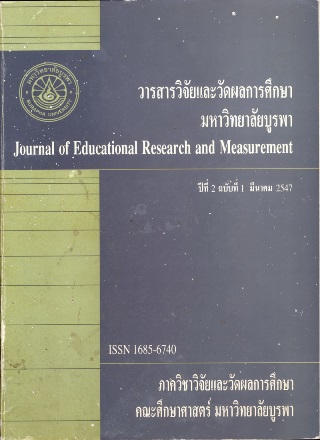การพัฒนาตัวบงชี้รวมการเสริมสรางพลังอํานาจครู ในโรงเรียนสังกัดสํานักงานคณะกรรมการการศึกษาขั้นพื้นฐาน
Main Article Content
Abstract
การวิจัยครั้งนี้มีวัตถุประสงคเพื่อพัฒนาตัวบงชี้รวมการเสริมสรางพลังอํานาจครู ในโรงเรียนสังกัด สํานักงานคณะกรรมการการศึกษาขั้นพื้นฐาน และตรวจสอบความตรงเชิงโครงสรางของโมเดลตัวบงชี้รวม โมเดล สมมติฐานการวิจัยสังเคราะหจากทฤษฎีโครงสรางอํานาจของแคนเตอร (Kanter, 1983) รูปแบบการเสริมสราง พลังอํานาจในองคการ (Scott & Jaffe, 1991) และแนวคิดการเสริมสรางพลงอั ํานาจครู (Short & Rinehart, 1992) กลมุ ตัวอยางประกอบดวย นักวิชาการจํานวน 80 คน และผูบริหารสถานศึกษาในโรงเรียนสังกัดสํานักงาน คณะกรรมการการศึกษาขั้นพื้นฐาน จํานวน 700 คน เครื่องมือที่ใชในการวิจัยคือแบบสอบถามความเหมาะสม ของตัวบงชี้การเสริมสรางพลังอํานาจครู การวิเคราะหคาสถิติเชิงบรรยายโดยใชโปรแกรม SPSS และใช โปรแกรมลิสเรล 8.50 ตรวจสอบความตรงของโมเดล ผลการวิจัยพบวา การเสริมสรางพลังอํานาจครู ประกอบดวย 2 มิติ (กระบวนการและผลลัพธ) 13 องคประกอบ 102 ตัวบงชี้ จัดอันดับความสําคัญตามน้ําหนักองคประกอบไดดังนี้ ความพึงพอใจในงาน การ สรางภาวะผูนํา การสรางทีมงาน ความผูกพันตอวิชาชีพครู ความกาวหนาในวิชาชีพ ความเปนอิสระ การให โอกาส การมีสวนรวมตัดสินใจ การสรางแรงจูงใจ สถานภาพครู ความเชื่อมั่นในตนเอง การใหการสนับสนุน และ ความรูสึกมีคุณคาในตน ผลการตรวจสอบความตรงเชิงโครงสรางของตัวบงชี้การเสริมสรางพลังอํานาจครู มีคา chi-square = 27.51, df = 61, p = 1.00, GFI = 1.00, AGFI = 0.99, CFI = 1.00, Standardized RMR = 0.01, RMSEA = 0.00 แสดงวา โมเดลตัวบงชี้รวมการเสริมสรางพลังอํานาจครูมีความตรงเชิงโครงสราง
DEVELOPMENT OF A COMPOSITE INDICATOR OF TEACHER EMPOWERMENT IN SCHOOLS UNDER THE JURISDICTION OF THE COMMISSION FOR BASIC EDUCATION
The objective of this study was to develop a composite indicator of teacher empowerment in those schools under the jurisdiction of the Commission for Basic Education, and to determine the construct validity of the resultant indicator. The hypothesized model was synthesized from Power Structure Theory (Kanter, 1983), from the pattern of empowerment in organization (Scott & Jaffe, 1991), and from the six dimensions of teacher empowerment (Short & Rinehart, 1992). The sample consisted of 80 experts in universities, and 700 principals in schools under the jurisdiction of the Commission for Basic Education. The research instrument was the Teacher Empowerment Questionnaire. Descriptive statistics were derived using SPSS, with LISREL 8.50 employed to validate the model. It was found that the teacher empowerment was comprised of two dimensions (process and outcome), 13 factors, and 102 indicators. The factors were labeled job satisfaction, leadership, teamwork, teacher professional commitment, professional growth, autonomy, opportunity, decided participation, motivation, teacher status, self-efficacy, support, and self-esteem. LISREL supported the hypothesized model, returning a chi – square figure of 27.51 with 61 degrees of freedom, p=1.00. Other resulting goodness of fit indices were: GFI = 1.00; AGFI = 0.99; CFI = 1.00; the standardized RMR = 0.01, and RMSEA = 0.00.

